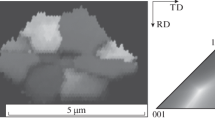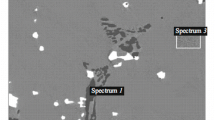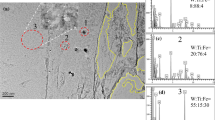Abstract
The results of studying the fine structure, chemical composition, and phase composition of boundaries between components of the Cr3C2–Ti hard alloy containing 40 wt % titanium binder in the state after the explosion compaction, as well as after heat treatment, are presented. The heating temperature of the powder mixture during the shock-wave loading is 730°C and the pressure is 14 GPa, which provides the maximal compaction and consolidation of the powder mixture without sintering. Compact samples are heat-treated at a temperature from 400 to 700°C with holding in the furnace for 1 h with subsequent cooling in calm air. The equilibrium phase composition is calculated by numerical thermodynamic modeling using the Thermo-Calc software complex. The structure and elemental composition are investigated using FEI Quanta 3D and Versa 3D electron microscopes with an integrated system of the focused ion beam for foil preparation, as well as FEI Techai G2 20F and Titan 80-300 transmission electron microscopes with the mode of transmission foil scanning. A Bruker D8 Advance diffractometer is used to perform X-ray phase analysis. It is shown that the formation of strong interphase boundaries during the explosion compaction of mixtures of titanium carbide and chromium carbide powders is accompanied by chemical interaction between components with the formation of near-boundary layers having a total thickness on the order of 90 nm. The continuous monotonic variation in Cr and Ti contents is observed in the limits of the transient layer with an almost invariable carbon concentration. The phase composition of the layers corresponds to the equilibrium one calculated under the shockwave compression pressure of 12 GPa, but it is thermodynamically nonequilibrium under standard conditions. Heating to 400°C leads to the dissolution of near-boundary layers and transition of Cr3C2–Ti hard alloys into the two-phase state. Alternating layers consisting of carbon-depleted chromium carbides (Cr7C3, Cr23C6) and titanium carbide (TiC), formed due to the carbon diffusion from the initial chromium carbide (Cr3C2) to titanium, are formed along interfacial boundaries at a temperature of 700°C.








Similar content being viewed by others
REFERENCES
Nesterenko, V.F., Dynamics of Heterogeneous Materials, New York: Springer Science + Business Media, 2001.
Rogozin, V.D., Vzryvnaya obrabotka poroshkovykh materialov (Explosive Treatment of Powder Materials), Volgograd: Politekhnik, 2002.
Prummer, R., Explosive Compaction of Powders and Composites, Boca Raton, FL: CRC Press, 2006.
Krokhalev, A.V., Kharlamov, V.O., Kuz’min, S.V., Lysak, V.I., and Pai, V.V., Explosive compaction of chromium carbide powders with a metallic binder, Combust., Explos., Shock Waves, 2019, vol. 55, no. 4, pp. 491–499.
Ageev, E.V., Latypov, R.A., and Ageeva, E.V., Investigation into the properties of electroerosive powders and hard alloy fabricated from them by isostatic pressing and sintering, Russ. J. Non-Ferrous Met., 2015, vol. 56, no. 1, pp. 52–62.
Panov, V.S. and Zaitsev, A.A., Development trends of technology of ultrafine and nanosized hard alloys WC‒Co, The Overlook, Izv. Vyssh. Uchebn. Zaved., Poroshk. Metall. Funkts. Pokrytiya, 2014, no. 3, pp. 38–48.
Kear, B.H., Skandan, G., and Sadangi, R.K., Factors controlling decarburization in HVOF sprayed nano-WC/Co hard coatings, Scr. Mater., 2001, vol. 44, nos. 8–9, pp. 1703–1707.
Kalita, V.I., Radyuk, A.A., Komlev, D.I., Ivannikov, A.Yu., Blagoveshchenskii, Yu.V., Grigorovich, K.V., Shibaeva, T.V., Umnova, N.V., Molokanov, V.V., Umnov, P.P., and Mel’nik, Yu.I., Mechanically alloy powder plasma WC–Co coatings, Fiz. Khim. Obrab. Mater., 2014, no. 5, pp. 22–29.
Mrdak, M.R., Mechanical properties and microstructure of vacuum plasma sprayed Cr3C2–25(Ni20Cr) coatings, Vojnoteh. Glas., 2015, vol. 63, no. 2, pp. 47–63.
Pirso, J. and Viljus, M., Structure formation of Cr3C2-based cermets during sintering, Proc Powder Metallurgy World Congress, Kyoto, 2000, pp. 1265–1268.
Duran, C. and Eroglu, S., Liquid-phase sintering and properties of Cr3C2/NiCr cermets, J. Mater. Process. Technol., 1998, vol. 74, nos. 1–3, pp. 69–73.
Al’tshuler, L.V., Trunin, R.F., Urlin, V.D., Fortov, V.E., and Funtikov, A.I., Development of dynamic high-pressure research methods in Russia, Usp. Fiz. Nauk, 1999, vol. 169, no. 3, pp. 323–344.
Lee, S.H. and Hokamoto, K., WC/Co coating on a mild steel substrate through underwater shock compaction using a self combustible material layer (WC/Co coating through underwater shock compaction), Mater. Trans., 2007, vol. 48, no. 1, pp. 80–83.
Yakovlev, I.V., Ogolikhin, V.M., and Shemelin, S.D., Explosive manufacturing of ceramic-metal protective containers, Vestn. Permsk. Nats. Issled. Politekh. Univ., Mashinostr. Materialoved., 2012, vol. 14, pp. 55–60.
Buzyurkin, A.E., Kraus, E.I., and Lukyanov, Y.L., Explosive compaction of WC + Co mixture by axisymmetric scheme, J. Phys.: Conf. Ser., 2015, vol. 653, no. 1, p. 012036.
Krokhalev, A.V., Kharlamov, V.O., Tupitsin, M.A., Kuz’min, S.V., and Lysak, V.I., Revisiting the possibility of formation of hard alloys from powder mixtures of carbides with metals by explosive compacting without sintering, Russ. J. Non-Ferrous Met., 2018, vol. 59, no. 5, pp. 550–556.
Bondar’, M.P. and Nesterenko, V.F., Contact deformation and bonding criteria under impulsive loading, Combust., Explos., Shock Waves, 1991, vol. 27, no. 3, pp. 364–376.
Bondar', M.P., Explosive compaction: the type of microstructure of contact boundaries produced by formation of a strong bond, Combust., Explos., Shock Waves, 2004, vol. 40, no. 4, pp. 489–497.
Bondar’, M.P., Obodovskii, E.S., and Psakh’e, S.G., A study into the microstructural features of the zone of contact interaction between powder particles at dynamic pressing, Fiz. Mezomekh., 2004, vol. 7, no. 3, pp. 17–23.
Krokhalev, A.V., Kharlamov, V.O., Kuz’min, S.V., and Lysak, V.I., Foundations of the fabrication technology of wear-resistant coatings made of mixtures of chromium carbide powders with a metallic binder by explosive pressing, Russ. J. Non-Ferrous Met., 2018, vol. 59, no. 4, pp. 419–432.
Tkachenko, Yu.G., Friction and wear of oxygen-free refractory compounds and materials based on them at high temperatures, Trenie Iznos, 1981, vol. 2, no. 5, pp. 864–876.
Lysak, V.I., Kuz’min, S.V., Krokhalev, A.V., and Grinberg, B.A., Structure of boundaries in composite materials obtained using explosive loading, Phys. Met. Metallogr., 2013, vol. 114, no. 11, pp. 947–952.
Wang, D.Y., Weng, K.W., Chang, C.L., and Ho, W.Y., Synthesis of Cr3C2 coatings for tribological applications, Surf. Coat. Technol., 1999, vol. 120, pp. 622–628.
Li, J.F., Huang, J.Q., Zhang, Y.F., and Ding, C.X., Tribological properties of plasma-sprayed coatings under water-lubricated sliding, J. Inorg. Mater., 1998, vol. 13, no. 4, pp. 519–520.
Lysak, V.I., Krokhalev, A.V., Kuz’min, S.V., Rogozin, V.D., and Kaunov, A.M., Pressovanie poroshkov vzryvom (Explosive Pressing of Powders), Moscow: Mashinostroenie, 2015.
Konyashin, I., Sologubenko, A., Weirich, T., and Ries, B., Complexion at WC-Co grain boundaries of cemented carbides, Mater. Lett., 2017, vol. 187, pp. 7–10.
Konyashin, I., Straumal, B.B., Ries, B., Bulatov, M.F., and Kolesnikova, K.I., Contact angles of WC/WC grain boundaries with binder in cemented carbides with various carbon content, Mater. Lett., 2017, vol. 196, pp. 1–3.
Konyashin, I., Zaitsev, A.A., Sidorenko, D., Levashov, E.A., Ries, B., Konischev, S.N., Sorokin, M., Mazilkin, A.A., Herrmann, M., and Kaiser, A., Wettability of tungsten carbide by liquid binders in WC–Co cemented carbides: Is it complete for all carbon contents?, Int. J. Refract. Met. Hard Mater., 2017, vol. 62, pp. 134–148.
Konyashin, I., Zaitsev, A., Meledin, A., Mayer, J., Loginov, P., Levashov, E., and Ries, B., Interfaces between model Co–WC alloys with various carbon contents and tungsten carbide, Materials, 2018, vol. 11, no. 3, p. 404.
Funding
This study was supported by the Russian Scientific Foundation, project no. 18-19-00518.
Author information
Authors and Affiliations
Corresponding authors
Ethics declarations
The authors declare that they have no conflict of interest.
Additional information
Translated by N. Korovin
About this article
Cite this article
Krokhalev, A.V., Kharlamov, V.O., Kuzmin, S.V. et al. Chemical Composition and Structure of Interfacial Boundaries in Cr3C2–Ti Powder Hard Alloys after Explosive Compaction and Subsequent Heating. Russ. J. Non-ferrous Metals 61, 667–674 (2020). https://doi.org/10.3103/S1067821220060139
Received:
Revised:
Accepted:
Published:
Issue Date:
DOI: https://doi.org/10.3103/S1067821220060139




